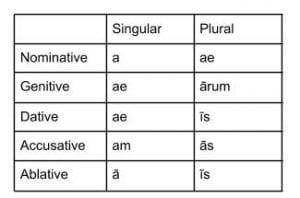Salvete! Some of you may be wondering why your scholar is being asked to memorize charts of certain letters and sounds without much explanation. This is actually the heart of classical education!
These charts are called declensions. So far the 3rd graders have learned two of these declension charts: 1st declension and 2nd declension. A declension is a chart of endings that different types of nouns can have.
Nouns in Latin are categorized as either 1st declension or 2nd declension nouns (and there are a few more types they’ll learn later). When they memorize these charts of noun endings, it’s not only good practice for memory, they engage their bodies in the memorization process by saying them, hearing them, visualizing them, and there’s movement involved with the fingers to help with the visualization. Chanting and memorizing are key components of classical education – and ancient Roman and Greek students memorized these same charts thousands of years ago.
They will have practical uses the more they learn of the Latin language. The labels of each row, called cases, are very important for how the noun is being used in the sentence. This is all information that students need in order to read Latin sentences as they get further along in their study.
We learn how to use these charts of endings little by little, and the first step is to memorize the entire chart. We always chant them in order, singular first, then plural, top to bottom. Here is what they look like and sound like. This is something you can always ask your scholar to chant for review and practice. They’ll be chanting these for years to come!
1st declension:

2nd declension:

